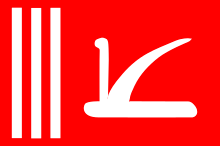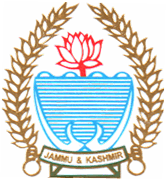Jammu and Kashmir
| Jammu and Kashmir | |||
|---|---|---|---|
| State | |||
 | |||
| |||
 Location of Jammu and Kashmir in India | |||
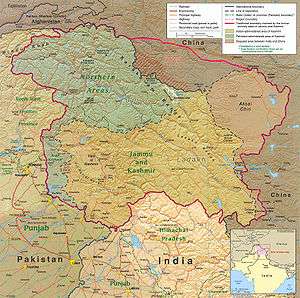 Map of Jammu and Kashmir | |||
| Coordinates (Srinagar): 33°27′N 76°14′E / 33.45°N 76.24°ECoordinates: 33°27′N 76°14′E / 33.45°N 76.24°E | |||
| Country |
| ||
| Admission to Union | 26 October 1947 | ||
| Capital |
Srinagar (Summer) Jammu (Winter) | ||
| Largest city | Srinagar | ||
| Districts | 22 | ||
| Government[*] | |||
| • Governor | Satya Pal Malik[1] | ||
| • Chief Minister | Vacant[2] | ||
| • Legislature | Bicameral (87 seats in the Assembly + 36 seats in the Council) | ||
| • Parliamentary constituency |
Rajya Sabha 4 Lok Sabha 6 | ||
| • High Court | Jammu and Kashmir High Court | ||
| Area | |||
| • Total | 101,338 km2 (39,127 sq mi) | ||
| Area rank | 5th | ||
| Highest elevation[3] | 7,135 m (23,409 ft) | ||
| Lowest elevation[4] | 305 m (1,001 ft) | ||
| Population (2011) | |||
| • Total | 12,541,302 | ||
| • Rank | 19th | ||
| • Density | 56/km2 (150/sq mi) | ||
| Time zone | UTC+05:30 (IST) | ||
| ISO 3166 code | IN-JK | ||
| HDI |
| ||
| HDI rank | 12th (2015) | ||
| Literacy | 68.74 (30th) | ||
| Official languages | Urdu[6] | ||
| Other spoken | Kashmiri, Dogri, Hindi, Punjabi, Ladakhi[6] | ||
| Website |
jk | ||
| Animal |
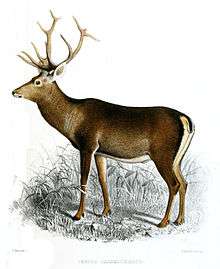 |
|---|---|
| Bird |
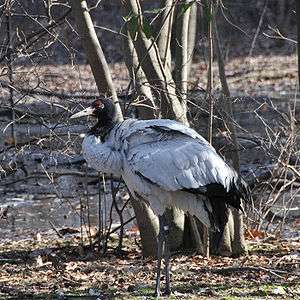 |
| Flower |
|
| Tree |
|
Jammu and Kashmir (/ˈdʒæmuː, ![]()
A part of the former Princely State of Kashmir and Jammu, the region is the subject of a territorial conflict among China, India and Pakistan. The western districts of the former princely state known as Azad Kashmir and the northern territories known as Gilgit-Baltistan have been under Pakistani control since 1947. The Aksai Chin region in the east, bordering Tibet, has been under Chinese control since 1962.[note 1]
Jammu and Kashmir consist of three regions: Jammu, the Kashmir Valley and Ladakh. Srinagar is the summer capital, and Jammu is the winter capital. Jammu and Kashmir is the only state in India with a Muslim-majority population.[16] The Kashmir valley is famous for its beautiful mountainous landscape, and Jammu's numerous shrines attract tens of thousands of Hindu pilgrims every year, while Ladakh is renowned for its remote mountain beauty and Buddhist culture.
History
Accession
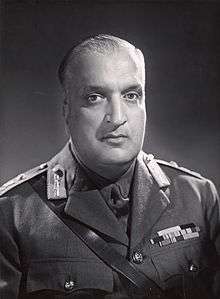
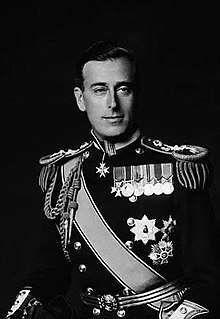
Maharaja Hari Singh became the ruler of the princely state of Jammu and Kashmir in 1925, and he was the reigning monarch at the conclusion of the British rule in the subcontinent in 1947. With the impending independence of India, the British announced that the British Paramountcy over the princely states would end, and the states were free to choose between the new Dominions of India and Pakistan or to remain independent. It was emphasized that independence was only a ‘theoretical possibility’ because, during the long rule of the British in India, the states had come to depend on British Indian government for a variety of their needs including their internal and external security.
Jammu and Kashmir had a Muslim majority (77% Muslim by the previous census in 1941[17]). Following the logic of Partition, many people in Pakistan expected that Kashmir would join Pakistan. However, the predominant political movement in the Valley of Kashmir (Jammu and Kashmir National Conference) was secular and was allied with the Indian National Congress since the 1930s. So many in India too had expectations that Kashmir would join India.[18][19] The Maharaja was faced with indecision.[note 2]
On 22 October 1947, rebellious citizens from the western districts of the State and Pushtoon tribesmen from the Northwest Frontier Province of Pakistan invaded the State, backed by Pakistan.[20][21] The Maharaja initially fought back but appealed for assistance to the India,[22][23] who agreed on the condition that the ruler accede to India.[24] Maharaja Hari Singh signed the Instrument of Accession on 26 October 1947 in return for military aid and assistance,[25] which was accepted by the Governor General the next day.[26][27] While the Government of India accepted the accession, it added the proviso that it would be submitted to a "reference to the people" after the state is cleared of the invaders, since "only the people, not the Maharaja, could decide where Kashmiris wanted to live." It was a provisional accession.[28][29][30][note 3]
Once the Instrument of Accession was signed, Indian soldiers entered Kashmir with orders to evict the raiders. The resulting Indo-Pakistani War of 1947 lasted till the end of 1948. At the beginning of 1948, India took the matter to the United Nations Security Council. The Security Council passed a resolution asking Pakistan to withdraw its forces as well as the Pakistani nationals from the territory of Jammu and Kashmir, and India to withdraw the majority of its forces leaving only a sufficient number to maintain law and order, following which a Plebiscite would be held. A ceasefire was agreed on 1 January 1949, supervised by UN observers.[31]
A special United Nations Commission for India and Pakistan (UNCIP) was set up to negotiate the withdrawal arrangements as per the Security Council resolution. The UNCIP made three visits to the subcontinent between 1948 and 1949, trying to find a solution agreeable to both India and Pakistan.[32] It passed a resolution in August 1948 proposing a three-part process. It was accepted by India but effectively rejected by Pakistan.[note 4] In the end, no withdrawal was ever carried out, India insisting that Pakistan had to withdraw first, and Pakistan contending that there was no guarantee that India would withdraw afterward.[33] No agreement could be reached between the two countries on the process of demilitarization.[34]
India and Pakistan fought two further wars in 1965 and 1971. Following the latter war, the countries reached the Simla Agreement, agreeing on a Line of Control between their respective regions and committing to a peaceful resolution of the dispute through bilateral negotiations.
Debate over accession
The primary argument for the continuing debate over the ownership of Kashmir is that India did not hold the promised plebiscite. In fact, neither side has adhered to the UN resolution of 13 August 1948; while India chose not to hold the plebiscite, Pakistan failed to withdraw its troops from Kashmir as was required under the resolution.
India gives the following reasons for not holding the plebiscite:
having solemnly resolved, in pursuance of the accession of this State to India which took place on the twenty-sixth day of October 1947, to further define the existing relationship of the State with the Union of India as an integral part thereof, and to secure to ourselves-
JUSTICE, social, economic and political;
LIBERTY of thought, expression, belief, faith, and worship;
EQUALITY of status and of opportunity; and to promote among us all;
FRATERNITY assuring the dignity of the individual and the unity of the nation;
IN OUR CONSTITUENT ASSEMBLY this seventeenth day of November, 1956, do HEREBY ADOPT, ENACT AND GIVE
TO OURSELVES THIS CONSTITUTION."-Preamble of Constitution of Jammu & Kashmir.[35]
- United Nations Security Council Resolution 47 on Kashmir was passed by UNSC under chapter VI of UN Charter, which are non binding and have no mandatory enforceability.[36][37] In March 2001, the then Secretary-General of the United Nations, Kofi Annan during his visit to India and Pakistan, remarked that Kashmir resolutions are only advisory recommendations and comparing with those on East Timor and Iraq was like comparing apples and oranges, since those resolutions were passed under chapter VII, which make it enforceable by UNSC.[38][39][40][41][42][43] In 2003, then Pakistan President Pervez Musharraf announced that Pakistan was willing to back off from demand for UN resolutions for Kashmir.[44][45][46]
- Moreover, India alleges that Pakistan failed to fulfill the pre-conditions by withdrawing its troops from the Kashmir region as was required under the same UN resolution of 13 August 1948 which discussed the plebiscite.[47][48][49][50]
- India has consistently told that UN resolutions are now completely irrelevant and Kashmir dispute is a bilateral issue and it has to be resolved under 1972 Simla Agreement and 1999 Lahore Declaration.[51][52][53]
- The 1948–49 UN resolutions can no longer be applied, according to India, because of changes in the original territory, with some parts "having been handed over to China by Pakistan and demographic changes having been effected in Azad Kashmir and the Northern Areas."
- Another reason for the abandonment of the referendum is because demographic changes after 1947 have been effected in Pakistan-administered Kashmir, as generations of Pakistani individuals non-native to the region have been allowed to take residence in Pakistan-administered Kashmir.[47][54] Furthermore, India alleges that in Jammu & Kashmir state of India, the demographics of the Kashmir Valley have been altered after separatist militants coerced 250,000 Kashmiri Hindus to leave the region.[55][56][57]
- India cites the 1951 elected Constituent assembly of Jammu and Kashmir, which voted in favour of confirming accession to India. Also, the 2014 assembly elections saw the highest voter turnout in the state in the last 25 years, prompting Prime Minister of India Narendra Modi to claim that it reflects the faith of the Kashmiri people in the democratic system of India and that they have given a "strong message to the world".[58][59]
In response Pakistan holds that:
- A statement from the British Cabinet Mission in India in 1946 confirmed that Jammu and Kashmir, a princely state at the time of partition, was a sovereign territory, and Article 7 of the Indian Independence Act of 1947 dealing with lapse of suzerainty of the British Crown over the Indian states reaffirmed this fact, so the Kashmiri people had a vested right of self-determination from the time of independence.[60]
- The Kashmiri's right of self-determination was further secured by the progressive development of customary international law in relation to this collective freedom. General Assembly Resolution 1514 (1960) firmly recognized the right of colonial people to self-determination; and General Assembly Resolution 2625 (1970) subsequently affirmed the right of internal self-determination, which the population of Kashmir has consistently been deprived of[60]
- The popular Kashmiri insurgency which erupted on 1989 demonstrates that the Kashmiri people no longer wish to remain within India. Pakistan suggests that this means that Kashmir either wants to be with Pakistan or independent.[61]
- According to the two-nation theory, which is one of the theories that is cited for the partition that created India and Pakistan, Kashmir should have been with Pakistan, because it has a Muslim majority.
- India has shown disregard to the resolutions of the UN Security Council and the United Nations Commission in India and Pakistan by failing to hold a plebiscite to determine the future allegiance of the state.[62]
- In 2007 there have been reports of extrajudicial killings in Indian-administered Kashmir by Indian security forces while claiming they were caught up in encounters with militants. The encounters go largely uninvestigated by the authorities, and the perpetrators are spared criminal prosecution.[63][64] Human rights organisations have strongly condemned Indian troops for widespread abuses and murder of civilians while accusing these civilians of being militants.[65][66][67]
Diplomatic relations between India and Pakistan soured for many other reasons[24] and eventually resulted in three further wars in Kashmir the Indo-Pakistani War of 1965, the Indo-Pakistan War of 1971 and the Kargil War in 1999. India has control of 60% of the area of the former Princely State of Jammu and Kashmir (Jammu, Kashmir Valley, Ladakh and Siachen Glacier); Pakistan controls 30% of the region (Gilgit–Baltistan and Azad Kashmir). China administers 10% (Aksai Chin and Trans-Karakoram Tract) of the state since 1962.
The Chenab formula was a compromise proposed in the 1960s, in which the Kashmir valley and other Muslim-dominated areas north of the Chenab river would go to Pakistan, and Jammu and other Hindu-dominated regions would go to India.[68]
The eastern region of the erstwhile princely state of Kashmir has also been beset with a boundary dispute. In the late 19th- and early 20th centuries, although some boundary agreements were signed between Great Britain, Tibet, Afghanistan and Russia over the northern borders of Kashmir, China never accepted these agreements, and the official Chinese position did not change with the communist revolution in 1949. By the mid-1950s the Chinese army had entered the northeast portion of Ladakh.[69]
By 1956–57 they had completed a military road through the Aksai Chin area to provide better communication between Xinjiang and western Tibet. India's belated discovery of this road led to border clashes between the two countries that culminated in the Sino-Indian war of October 1962.[70] China has occupied Aksai Chin since 1962 and, in addition, an adjoining region, the Trans-Karakoram Tract was ceded by Pakistan to China in 1963.
For intermittent periods between 1957, when the state approved its own Constitution,[71] and the death of Sheikh Abdullah in 1982, the state had alternating spells of stability and discontent. In the late 1980s, however, simmering discontent over the high-handed policies of the Union Government[72] and allegations of the rigging of the 1987 assembly elections[72] triggered a violent uprising which was backed by Pakistan.[73]
Since then, the region has seen a prolonged, bloody conflict between separatists and the Indian Army, both of whom have been accused of widespread human rights abuses, including abductions, massacres, rapes and armed robbery.[74][75][76][77][78][79][80][81][82][83] The army has officially denied these allegations.[84] However, violence in the state has been on the decline since 2004 with the peace process between India and Pakistan.[85]
Geography and climate
Jammu and Kashmir is home to several valleys such as the Kashmir Valley, Tawi Valley, Chenab Valley, Poonch Valley, Sind Valley and Lidder Valley. The main Kashmir Valley is 100 km (62 mi) wide and 15,520.3 km2 (5,992.4 sq mi) in area. The Himalayas divide the Kashmir valley from Ladakh while the Pir Panjal range, which encloses the valley from the west and the south, separates it from the Great Plains of northern India. Along the northeastern flank of the Valley runs the main range of the Himalayas. This densely settled and beautiful valley has an average height of 1,850 metres (6,070 ft) above sea-level but the surrounding Pir Panjal range has an average elevation of 5,000 metres (16,000 ft).
Because of Jammu and Kashmir's wide range of elevations, its biogeography is diverse. Northwestern thorn scrub forests and Himalayan subtropical pine forests are found in the low elevations of the far southwest. These give way to a broad band of western Himalayan broadleaf forests running from northwest-southeast across the Kashmir Valley. Rising into the mountains, the broadleaf forests grade into western Himalayan subalpine conifer forests. Above the tree line are found northwestern Himalayan alpine shrub and meadows. Much of the northeast of the state is covered by the Karakoram-West Tibetan Plateau alpine steppe. Around the highest elevations, there is no vegetation, simply rock and ice.
| Division | Area km2 | Percentage Area |
|---|---|---|
| Kashmir | 15,948 | 15.73% |
| Jammu | 26,293 | 25.93% |
| Ladakh | 59,146 | 58.33% |
| India-administrated Jammu and Kashmir | 101,387 km2 | 100% |
The Jhelum River is the only major Himalayan river which flows through the Kashmir valley. The Indus, Tawi, Ravi and Chenab are the major rivers flowing through the state. Jammu and Kashmir is home to several Himalayan glaciers. With an average altitude of 5,753 metres (18,875 ft) above sea-level, the Siachen Glacier is 76 km (47 mi) long making it the longest Himalayan glacier.
The climate of Jammu and Kashmir varies greatly owing to its rugged topography. In the south around Jammu, the climate is typically monsoonal, though the region is sufficiently far west to average 40 to 50 mm (1.6 to 2 inches) of rain per month between January and March. In the hot season, Jammu city is very hot and can reach up to 40 °C (104 °F) whilst in July and August, very heavy though erratic rainfall occurs with monthly extremes of up to 650 millimeters (25.5 inches). In September, rainfall declines, and by October conditions are hot but extremely dry, with minimal rainfall and temperatures of around 29 °C (84 °F).
Across from the Pir Panjal range, the South Asian monsoon is no longer a factor and most precipitation falls in the spring from southwest cloudbands. Because of its closeness to the Arabian Sea, Srinagar receives as much as 635 millimetres (25 in) of rain from this source, with the wettest months being March to May with around 85 millimetres (3.3 inches) per month. Across from the main Himalaya Range, even the southwest cloudbands break up and the climate of Ladakh and Zanskar is extremely dry and cold. Annual precipitation is only around 100 mm (4 inches) per year and humidity is very low. In this region, almost all above 3,000 metres (9,750 ft) above sea level, winters are extremely cold. In Zanskar, the average January temperature is −20 °C (−4 °F) with extremes as low as −40 °C (−40 °F). All the rivers freeze over and locals make river crossings during this period because their high levels from glacier melt in summer inhibits crossing. In summer in Ladakh and Zanskar, days are typically a warm 20 °C (68 °F), but with the low humidity and thin air nights can still be cold.
 Indus River near Leh
Indus River near Leh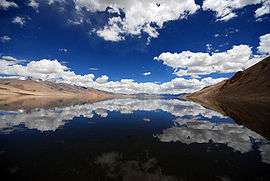 Lake Tso Moriri
Lake Tso Moriri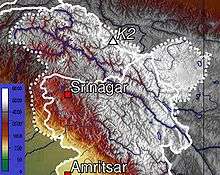 Topographic map of J&K (Kashmir valley, Jammu region and Ladakh region are visible by altitude)
Topographic map of J&K (Kashmir valley, Jammu region and Ladakh region are visible by altitude)- Mountains in Jammu and Kashmir
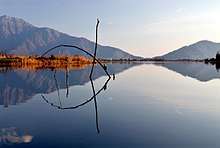 Nageen Lake
Nageen Lake.jpg)
- View from the Gulmarg slopes. Cable car is used as ski lift
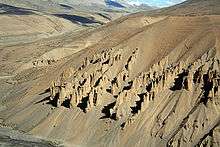 Natural Rock and Sand Formations along Sumkhel Lungpa River in More Plains
Natural Rock and Sand Formations along Sumkhel Lungpa River in More Plains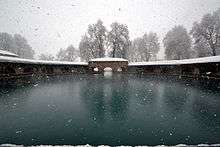 Verinag Spring, the source of Jhelum River.
Verinag Spring, the source of Jhelum River. Kargil town at elevation of 8,780 ft
Kargil town at elevation of 8,780 ft
Administrative divisions

Jammu and Kashmir consists of three divisions: Jammu, Kashmir Valley and Ladakh, and is further divided into 22 districts.[86] The Siachen Glacier, although under Indian military control, does not lie under the administration of the state of Jammu and Kashmir. Kishtwar, Ramban, Reasi, Samba, Bandipora, Ganderbal, Kulgam and Shopian are newly formed districts, and their areas are included with those of the districts from which they were formed.[86]
| Division | Name | Headquarters | Area (km²) | Population 2001 Census | Population 2011 Census |
|---|---|---|---|---|---|
| Jammu | Kathua District | Kathua | 2,651 | 550,084 | 615,711 |
| Jammu District | Jammu | 3,097 | 1,343,756 | 1,526,406 | |
| Samba District | Samba | 904 | 245,016 | 318,611 | |
| Udhampur District | Udhampur | 4,550 | 475,068 | 555,357 | |
| Reasi District | Reasi | 1,719 | 268,441 | 314,714 | |
| Rajouri District | Rajouri | 2,630 | 483,284 | 619,266 | |
| Poonch District | Poonch | 1,674 | 372,613 | 476,820 | |
| Doda District | Doda | 11,691 | 320,256 | 409,576 | |
| Ramban District | Ramban | 1,329 | 180,830 | 283,313 | |
| Kishtwar District | Kishtwar | 1,644 | 190,843 | 231,037 | |
| Total for division | Jammu | 26,293 | 4,430,191 | 5,350,811 | |
| Kashmir Valley | Anantnag District | Anantnag | 3,984 | 734,549 | 1,069,749 |
| Kulgam District | Kulgam | 1,067 | 437,885 | 423,181 | |
| Pulwama District | Pulwama | 1,398 | 441,275 | 570,060 | |
| Shopian District | Shopian | 612.87 | 211,332 | 265,960 | |
| Budgam District | Budgam | 1,371 | 629,309 | 755,331 | |
| Srinagar District | Srinagar | 2,228 | 990,548 | 1,250,173 | |
| Ganderbal District | Ganderbal | 259 | 211,899 | 297,003 | |
| Bandipora District | Bandipora | 398 | 316,436 | 385,099 | |
| Baramulla District | Baramulla | 4,588 | 853,344 | 1,015,503 | |
| Kupwara District | Kupwara | 2,379 | 650,393 | 875,564 | |
| Total for division | Srinagar | 15,948 | 5,476,970 | 6,907,622 | |
| Ladakh | Kargil District | Kargil | 14,036 | 119,307 | 143,388 |
| Leh District | Leh | 45,110 | 117,232 | 147,104 | |
| Total for division | Leh | 59,146 | 236,539 | 290,492 | |
| Total | 101,387 | 10,143,700 | 12,548,925 | ||
Major cities
Municipal corporations: 2 – Srinagar, Jammu
Municipal councils: 6 – Udhampur, Kathua, Poonch, Anantnag, Baramulla, Sopore
Municipal boards: 21 – Samba, Ranbirsinghpora, Akhnoor, Reasi, Ramban, Doda, Bhaderwah, Kishtwar, Kargil, Dooru-Verinag, Bijbehara, Pulwama, Tral, Badgam, Kulgam, Shopian, Ganderbal, Pattan, Sumbal, Kupwara, Handwara
Population of ten major cities:
| Name | Rank | Population 2011 Census | State Region |
|---|---|---|---|
| Jammu | 1 | 1,529,958 | Jammu[87] |
| Srinagar | 2 | 1,236,829 | Kashmir [87] |
| Anantnag | 3 | 1,078,692 | Kashmir[87] |
| Baramulla | 4 | 1,008,039 | Kashmir[87] |
| Udhampur | 5 | 554,985 | Jammu[87] |
| Rajouri | 6 | 642,415 | Jammu[87] |
| Kathua | 7 | 616,435 | Jammu[87] |
| Sopore | 8 | - | Kashmir |
| Poonch | 9 | - | Jammu |
| Bandipora | 10 | - | Kashmir |
Demographics
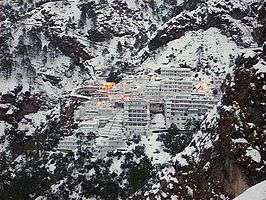
| Population increase | |||
|---|---|---|---|
| Census | Pop. | %± | |
| 1951 | 3,254,000 | — | |
| 1961 | 3,561,000 | 9.4% | |
| 1971 | 4,617,000 | 29.7% | |
| 1981 | 5,987,000 | 29.7% | |
| 1991 | 7,837,000 | 30.9% | |
| 2001 | 10,143,700 | 29.4% | |
| 2011 | 12,548,926 | 23.7% | |
| Source:Census of India[88][89] The 1991 Census could not be held in Jammu and Kashmir, the 1991 population is interpolated. | |||
The major ethnic groups living in Jammu and Kashmir include Kashmiris, Gujjars/Bakarwals, Paharis, Dogras and Ladakhis.[91] The Kashmiris live mostly in the main valley of Kashmir and Chenab valley of Jammu division with a minority living in the Pir Panjal region. The Pahari-speaking people mostly live in and around the Pir Panjal region with some in the northern Kashmir valley. The nomadic Gujjars and Bakerwals practice transhumance and mostly live in the Pirpanjal region. The Dogras are ethnically, linguistically and culturally related to the neighboring Punjabi people and mostly live in the Udhampur and Jammu districts of the state. The Ladakhis inhabit Ladakh region.
Jammu and Kashmir is one of India's two administrative divisions (the other being the Union territory of Lakshadweep which is overwhelmingly Muslim) with a Muslim majority population. According to the 2011 census, Islam is practised by about 68.3% of the state population,[92] while 28.4% follow Hinduism and small minorities follow Sikhism (1.9%), Buddhism (0.9%) and Christianity (0.3%).[90] About 96.4% of the population of the Kashmir valley are Muslim followed by Hindus (2.45%) and Sikhs (0.98%) and others (0.17%)[93] Shias live in the district of Badgam, where they are a majority.[94] The Shia population is estimated to comprise 14% of the state's population.[95]
In Jammu, Hindus constitute 62.55% of the population, Muslims 33.45% and Sikhs, 3.3%; In Ladakh (comprises Buddhists-dominated Leh and Shia Muslim-dominated Kargil), Muslims constitute about 46.4% of the population, the remaining being Buddhists (39.7%) and Hindus (12.1%).[93] The people of Ladakh are of Indo-Tibetan origin, while the southern area of Jammu includes many communities tracing their ancestry to the nearby Indian states of Haryana and Punjab, as well as the city of Delhi.
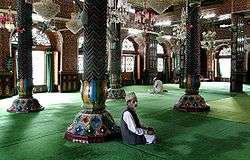
According to political scientist Alexander Evans, approximately 99% of the total population of 160,000–170,000 of Kashmiri Brahmins, also called Kashmiri Pandits, (i.e. approximately 150,000 to 160,000) left the Kashmir Valley in 1990 as militancy engulfed the state.[96] According to an estimate by the Central Intelligence Agency, about 300,000 Kashmiri Pandits from the entire state of Jammu and Kashmir have been internally displaced due to the ongoing violence.[97]
The pre-independence Census of 1941 recorded Muslims as constituting 72.41% of the population, and Hindus 25.01%. In the 1961 census, the first one to be conducted after the partition of the State, Muslims constituted 68.31% of the population and Hindus 28.45%. The proportion of Muslims fell to 64.19% by 1981 but recovered afterward, reaching 68.31% again by 2011.[98]
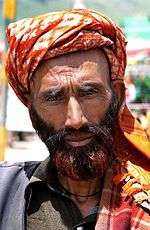
| Division | % Area | % Population | Population | % Muslim | % Hindu | % Sikh | % Buddhist and other |
|---|---|---|---|---|---|---|---|
| Kashmir | 15.73% | 54.93% | 6,888,475 | 96.40% | 2.45% | 0.98% | 0.17% |
| Jammu | 25.93% | 42.89% | 5,378,538 | 33.45% | 62.55% | 3.30% | 0.70% |
| Ladakh | 58.33% | 2.18% | 274,289 | 46.40% | 12.11% | 0.82% | 39.67% |
| Jammu and Kashmir | 100% | 100% | 12,541,302 | 68.31% | 28.43% | 1.87% | 0.89% |
| |||||||
In Jammu and Kashmir, the principal spoken languages are Kashmiri, Urdu, Dogri, Hindi, Punjabi, Pahari, Balti, Ladakhi, Gojri, Shina and Pashto. However, Urdu written in the Persian script is the official language of the state. Hindustani is widely understood by peoples. Many speakers of these languages use Urdu or English as a second language.[103]
Urdu occupies a central space in media, education, religious and political discourses, and the legislature of Jammu and Kashmir. The language is said to function as a symbol of identity among Muslims of South Asia.[104] Additionally, as the language is regarded as a "neutral" and non-native language of the multilingual region, its acceptance was broadly accepted by Kashmiri Muslims.[105] The use of Urdu as the official language of Jammu and Kashmir has also been criticised by Rajeshwari V. Pandharipande of the University of Illinois on the basis that the language is spoken as a native language by less than 1% of the population, and has rendered Kashmiri, spoken by 53% of the population, into a functional "minority language," effectively restricting its use to home and family.[106][107]
The Kashmir Valley is dominated by ethnic Kashmiris, who have largely driven the campaign for secession from India. Non-Kashmiri Muslim ethnic groups (Paharis, Gujjars and Bakarwalas), who dominate areas along the Line of Control, have remained indifferent to the separatist campaign. Jammu province region has a 70:30 Hindu-Muslim ratio. Parts of the region were hit by militants, but violence has ebbed there, along with the Valley, after India and Pakistan started a peace process in 2004.[108]
Dogras (67%) are the single largest group in the multi-ethnic region of Jammu living with Punjabis, Kashmiris, Paharis, Bakerwals and Gujjars. Statehood is demanded in Hindu-dominated districts. Ladakh is the largest region in the state with over 200,000 people. Its two districts are Leh (68% Buddhist) and Kargil (91% Muslim population). Union territory status has been the key demand of Leh Buddhists for many years.[108]
Politics and government

Jammu and Kashmir is the only state in India which enjoys special autonomy under Article 370 of the Constitution of India, according to which no law enacted by the Parliament of India, except for those in the field of defence, communication and foreign policy, will be extendable in Jammu and Kashmir unless it is ratified by the state legislature of Jammu and Kashmir. Subsequently, jurisdiction of the Supreme Court of India over Jammu and Kashmir has been extended.[109]
Jammu and Kashmir is the only Indian state to have its own official state flag along with national flag[110] and constitution. Indians from other states cannot purchase land or property in the state.[111] Designed by the then ruling National Conference, the flag of Jammu and Kashmir features a plough on a red background symbolising labour; it replaced the Maharaja's state flag. The three stripes represent the three distinct administrative divisions of the state, namely Jammu, Valley of Kashmir, and Ladakh.[112]
In 1990, an Armed Forces Act, which gives special powers to the Indian security forces, has been enforced in Jammu and Kashmir.[113] The decision to invoke this act was criticised by the Human Rights Watch.[114] Amnesty International has strongly condemned the implementation of this Act that grants virtual immunity to security forces from prosecution.[115] Minar Pimple, Senior Director of Global Operations at Amnesty International states.[116]
Like all the states of India, Jammu and Kashmir has a multi-party democratic system of governance with a bicameral legislature. At the time of drafting the Constitution of Jammu and Kashmir, 100 seats were earmarked for direct elections from territorial constituencies. Of these, 25 seats were reserved for the areas of Jammu and Kashmir State that came under Pakistani occupation; this was reduced to 24 after the 12th amendment of the Constitution of Jammu and Kashmir:[117]
"The territory of the State shall comprise all the territories which on the fifteenth day of August 1947, were under the sovereignty or suzerainty of the Ruler of the State" and Section 48 therein states that, "Notwithstanding anything contained in section 47, until the area of the State under the occupations of Pakistan ceases to so occupied and the people residing in that area elect their representatives (a) twenty-five seats in the Legislative Assembly shall remain vacant and shall not be taken into account for reckoning the total member-ship of the Assembly; and the said area shall be excluded in delimiting the territorial Constituencies Under Section 47".
After a delimitation in 1988, the total number of seats increased to 111, of which 87 were within Indian-administered territory.[118] The Jammu & Kashmir Assembly is the only state in India to have a 6-year term, in contrast to the norm of a 5-year term followed in every other state's Assembly.[119] There was indication from the previous INC Government to bring parity with the other states,[120] but this does not seem to have received the required support to pass into law.
Influential political parties include the Jammu & Kashmir National Conference (NC), the Indian National Congress (INC), the Jammu and Kashmir People's Democratic Party (PDP), the Bharatiya Janata Party (BJP) and other smaller regional parties. After dominating Kashmir's politics for years, the National Conference's influence waned in 2002, when INC and PDP formed a political alliance and rose to power.[121] Under the power-sharing agreement, INC leader Ghulam Nabi Azad replaced PDP's Mufti Mohammad Sayeed as the Chief Minister of Jammu and Kashmir in late 2005. However, in 2008, PDP withdrew its support from the government on the issue of temporary diversion of nearly 40 acres (16 ha) of land to the Sri Amarnath Shrine Board.[122] In the 2008 Kashmir Elections that were held from 17 November to 24 December, the National Conference party and the Congress party together won enough seats in the state assembly to form a ruling alliance.[123] In the 2014 election, the voter turnout was recorded at 65% – the highest in the history of the state. The results gave a fractured mandate to either parties – the PDP won 28 seats, BJP 25, NC 15 and INC 12. After 2 months of deliberations and president's rule, the BJP and the PDP announced an agreement for a coalition government, and PDP patron Mufti Mohammad Sayeed was sworn-in as CM for a second term, with Nirmal Singh of the BJP sworn-in as deputy CM. This also marked the first time in 35 years that the BJP was a coalition partner in the state government.
The state has two autonomous councils in Ladakh, these are the LAHDC Leh and LAHDC Kargil.
Separatist insurgency and militancy since 1989
In 1989, a widespread popular and armed insurgency[124][125] started in Kashmir. After the 1987 state legislative assembly election, some of the results were disputed. This resulted in the formation of militant wings and marked the beginning of the Mujahadeen insurgency, which continues to this day.[126] India contends that the insurgency was largely started by Afghan mujahadeen who entered the Kashmir valley following the end of the Soviet–Afghan War.[127] Yasin Malik, a leader of one faction of the Jammu Kashmir Liberation Front, was one of the Kashmiris to organise militancy in Kashmir, along with Ashfaq Majid Wani and Farooq Ahmed Dar (alias Bitta Karate). Since 1995, Malik has renounced the use of violence and calls for strictly peaceful methods to resolve the dispute. Malik developed differences with one of the senior leaders, Farooq Siddiqui (alias Farooq Papa), for shunning demands for an independent Kashmir and trying to cut a deal with the Indian Prime Minister. This resulted in a split in which Bitta Karate, Salim Nanhaji, and other senior comrades joined Farooq Papa.[128][129] Pakistan claims these insurgents are Jammu and Kashmir citizens and are rising up against the Indian army as part of an independence movement. Amnesty International has accused security forces in Indian-controlled Kashmir of exploiting an Armed Forces (Special Powers) Act that enables them to "hold prisoners without trial". The group argues that the law, which allows security forces to detain individuals for up to two years without presenting charges violates prisoners' human rights.[130][131] In 2011, the state humans right commission said it had evidence that 2,156 bodies had been buried in 40 graves over the last 20 years.[131] The authorities deny such accusations. The security forces say the unidentified dead are militants who may have originally come from outside India. They also say that many of the missing people have crossed into Pakistan-administered Kashmir to engage in militancy.[131] However, according to the state human rights commission, among the identified bodies 574 were those of "disappeared locals", and according to Amnesty International's annual human rights report (2012) it was sufficient for "belying the security forces' claim that they were militants".[132]
Separatist violence in the region has been observed to decline.[133] However, following the unrest in 2008, which included more than 500,000 protesters at a rally on 18 August, secessionist movements gained a boost.[134][135] Further the 2016–17 Kashmir Unrest culminated in the deaths of more than 90 civilians,[136] with over 15,000 civilians injured.[137]
The 2009 edition of the Freedom in the World (report) by the US-based NGO Freedom House rated Jammu and Kashmir as "Partly Free",[138] while in comparison, the same report rated Pakistan-administered Kashmir as "Not Free."[139] However, in the same report the Political rights and Civil liberties scored 6 and 5 respectively for Azad Kashmir[139] while as for Jammu and Kashmir[138] the scores were 5 and 4 respectively.
Six policemen, including a sub-inspector were killed in an ambush by militants in Anantnag, Jammu and Kashmir on June 15, 2017, by trespassing militants of the Pakistan-based Lashkar-e-Toiba. 116 illegal trespassing cases along the India-Pak border in Jammu and Kashmir were reported in 2015 and 2016, including 88 in 2016. A total of 59 Army personnel have lost their lives in counter-terror operations in J&K since 2016.[140]
Economy
| Statistics | |
|---|---|
| GDP | ₹1.32 lakh crore (US$18 billion) (2016–17 est.) |
| GDP rank | 21st |
GDP growth | 14% (2016–17 est.)[141] |
GDP by sector |
Agriculture 22% Industry 25% Services 53% (2015)[141] |
Labour force by occupation |
Agriculture 64% Industry 11% Services 25% (2015) [141] |
| Public finances | |
| 49.25% of GDP (2016–17 est.)[141] | |
| Revenues | ₹53,202 crore (US$7.4 billion) (2016–17 est.)[141] |
| Expenses | ₹64,669 crore (US$9.0 billion) (2016–17 est.)[141] |
|
All values, unless otherwise stated, are in US dollars. | |

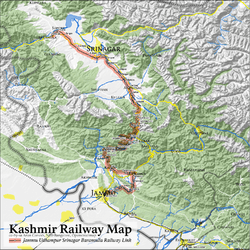
Jammu and Kashmir's economy is predominantly dependent on agriculture and allied activities.[145] The Kashmir Valley is known for its sericulture and cold-water fisheries. Wood from Kashmir is used to make high-quality cricket bats, popularly known as Kashmir Willow. Kashmiri saffron is very famous and brings the state a handsome amount of foreign exchange. Agricultural exports from Jammu and Kashmir include apples, barley, cherries, corn, millet, oranges, rice, peaches, pears, saffron, sorghum, vegetables, and wheat, while manufactured exports include handicrafts, rugs, and shawls.
Horticulture plays a vital role in the economic development of the state. With an annual turnover of over ₹3 billion (US$42 million), apart from foreign exchange of over ₹800 million (US$11 million), this sector is the next biggest source of income in the state's economy.[146] The region of Kashmir is known for its horticulture industry[147] and is the wealthiest region in the state.[148] Horticultural produce from the state includes apples, apricots, cherries, pears, plums, almonds and walnuts.[146]
The Doda district has deposits of high-grade sapphire.[149] Though small, the manufacturing and services sector is growing rapidly, especially in the Jammu division. In recent years, several consumer goods companies have opened manufacturing units in the region. The Associated Chambers of Commerce and Industry of India (ASSOCHAM) has identified several industrial sectors which can attract investment in the state, and accordingly, it is working with the union and the state government to set up industrial parks and special economic zones.[150] In the fiscal year 2005–06, exports from the state amounted to ₹11.5 billion (US$160 million).[151] However, industrial development in the state faces several major constraints including extreme mountainous landscape and power shortage.[152] The Jammu & Kashmir Bank, which is listed as a S&P CNX 500 conglomerate, is based in the state. It reported a net profit of ₹598 million (US$8.3 million) in 2008.[153]
The Government of India has been keen to economically integrate Jammu and Kashmir with the rest of India. The state is one of the largest recipients of grants from New Delhi, totalling US$812 million per year.[154] It has a mere 4% incidence of poverty, one of the lowest in the country.[154]
In an attempt to improve the infrastructure in the state, Indian Railways is constructing the ambitious Jammu–Baramulla line project at a cost of more than US$2.5 billion.[155] Trains run on the 130 km Baramula-Banihal section. The 17.5 km Qazigund-Banihal section through the 11 km long Pir Panjal Railway Tunnel was commissioned. Udhampur-Katra section of the track was commissioned early in July 2014. The Katra-Banihal section is under construction. The route crosses major earthquake zones and is subjected to extreme temperatures of cold and heat, as well as inhospitable terrain, making it an extremely challenging engineering project. It is expected to increase tourism and travel to Kashmir. Three other railway lines, the Bilaspur–Mandi–Leh railway, Srinagar-Kargil-Leh railway and the Jammu-Poonch railway have been proposed.
| Year | State's Gross Domestic Product (in million INR) |
|---|---|
| 1980 | 11,860 |
| 1985 | 22,560 |
| 1990 | 36,140 |
| 1995 | 80,970 |
| 2000 | 147,500 |
| 2006 | ₹539,850 million (US$7.5 billion) |
| 2016 | ₹132,307 crore (US$18 billion)[156] |
Agriculture
Given below is a table of 2015 national output share of select agricultural crops and allied segments in Jammu and Kashmir based on 2011 prices[157]
| Segment | National Share % |
|---|---|
| Walnut | 94.1 |
| Cherry | 93.8 |
| Almond | 90.5 |
| Apple | 25.2 |
| Pear | 22.3 |
| Wool and hair | 10.1 |
Tourism
Before the insurgency intensified in 1989, tourism formed an important part of the Kashmiri economy. The tourism economy in the Kashmir valley was worst hit. However, the holy shrines of Jammu and the Buddhist monasteries of Ladakh continue to remain popular pilgrimage and tourism destinations. Every year, thousands of Hindu pilgrims visit holy shrines of Vaishno Devi and Amarnath, which has had significant impact on the state's economy.[158] It was estimated in 2007 that the Vaishno Devi yatra contributed ₹4.75 billion (US$66 million) to the local economy annually a few years ago.[159] The contribution should be significantly greater now as the numbers of Indian visitors have increased considerably. Foreign tourists have been slower to return. The British government still advises against all travel to Jammu and Kashmir with the exception of the cities of Jammu and Srinagar, travel between these two cities on the Jammu-Srinagar highway, and the region of Ladakh,[160] while Canada excludes the entire region excepting Leh.
Besides Kashmir, several areas in the Jammu region have a lot of tourist potential as well. Bahu Fort in Jammu city is the major attraction for the tourists visiting that city. Bage-e-Bahu is another tourist destination. The local aquarium, established by the fisheries department, is visited by many. Tourists from across India visit Jammu in a pilgrimage to Mata Vaishno Devi. Mata Vaishno Devi is located in the Trikuta Hills, about 40 to 45 km from Jammu City. Approximately 10 million Pilgrims visit this holy place every year.
Tourism in the Kashmir valley has rebounded in recent years, and in 2009, the state became one of the top tourist destinations of India.[161] Gulmarg, one of the most popular ski resort destinations in India, is also home to the world's highest green golf course.[162] The state's recent decrease in violence has boosted the economy and tourism.[163] It was reported that more than a million tourists visited Kashmir in 2011.[164][165][166]
Culture
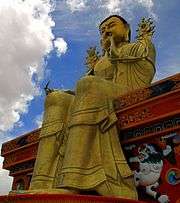
Ladakh is famous for its unique Indo-Tibetan culture. Chanting in Sanskrit and Tibetan language forms an integral part of Ladakh's Buddhist lifestyle. Annual masked dance festivals, weaving and archery are an important part of traditional life in Ladakh. Ladakhi food has much in common with Tibetan food, the most prominent foods being thukpa, noodle soup; and tsampa, known in Ladakhi as Ngampe, roasted barley flour. Typical garb includes gonchas of velvet, elaborately embroidered waistcoats and boots, and gonads or hats. People adorned with gold and silver ornaments and turquoise headgears throng the streets during Ladakhi festivals.
The Dumhal is a famous dance in the Kashmir Valley, performed by men of the Wattal region. The women perform the Rouff, another traditional folk dance. Kashmir has been noted for its fine arts for centuries, including poetry and handicrafts. Shikaras, traditional small wooden boats, and houseboats are a common feature in lakes and rivers across the Valley.
Due to the special status the State enjoys in the Indian Union, people from outside the state cannot purchase land in the state. As a consequence, houseboats became popular among those who were unable to purchase land in the Valley and have now become an integral part of the Kashmiri lifestyle.
Kehwa, traditional green tea with spices and almond, is consumed all through the day in the chilly winter climate of Kashmir. Most of the buildings in the Valley and Ladakh are made from softwood and are influenced by Indian, Tibetan, and Islamic architecture.
Jammu's Dogra culture and tradition is very similar to that of neighboring Punjab and Himachal Pradesh. Traditional Punjabi festivals such as Lohri and Vaisakhi are celebrated with great zeal and enthusiasm throughout the region, along with Accession Day, an annual holiday which commemorates the accession of Jammu & Kashmir to the Dominion of India.[167] After Dogras, Gujjars form the second-largest ethnic group in Jammu. Known for their semi-nomadic lifestyle, Gujjars are also found in large numbers in the Kashmir Valley. Similar to Gujjars, Gaddis are primarily herdsmen who hail from the Chamba region in Himachal Pradesh. Gaddis is generally associated with emotive music played on the flute. The Bakkarwalas found both in Jammu and the Kashmir valley is wholly nomadic pastoral people who move along the Himalayan slopes in search of pastures for their huge flocks of goats and sheep.
The Shri Pratap Singh Museum in Srinagar is the main repository of Kashmiri elite culture and royal heritage. The Meeras Mahal in Noor Bagh, near Sopore, founded by Atiqa Bano, holds the material and artistic heritage of the common folk.[168]
Education

In 1970, the state government of Jammu and Kashmir established its own education board and university. Education in the state is divided into primary, middle, high secondary, college and university level. Jammu and Kashmir follows the 10+2 pattern for education of children. This is handled by Jammu and Kashmir State Board of School Education (abbreviated as JKBOSE). Private and public schools are recognized by the board to impart education to students. Board examinations are conducted for students in class VIII, X and XII. In addition, there are Kendriya Vidyalayas (run by the Government of India) and Indian Army schools that impart secondary school education. These schools follow the Central Board of Secondary Education pattern.
Notable higher education or research institutes in Jammu and Kashmir include the Indian Institute of Technology Jammu, Indian Institute of Management Jammu, National Institute of Technology, Srinagar, All India Institute of Medical Sciences, Jammu, Sher-i-Kashmir Institute of Medical Sciences, Srinagar, Government College of Engineering and Technology, Jammu, Government Medical College, Srinagar, All India Institute of Medical Science Awantipora , Acharya Shri Chandra college of medical sciences, Jammu and Government Medical College, Jammu, University-level education is provided by University of Kashmir, University of Jammu, Sher-e-Kashmir University of Agricultural Sciences and Technology, Srinagar, Sher-e-Kashmir University of Agricultural Sciences and Technology, Jammu, Islamic University of Science & Technology, Baba Ghulam Shah Badhshah University, Shri Mata Vaishno Devi University, Institution of Technicians and Engineers (Kashmir), Islamia College of Science and Commerce, Srinagar, Central University of Kashmir located at Ganderbal and Central University of Jammu located at Raya Suchani in the Samba district of Jammu.
Sports
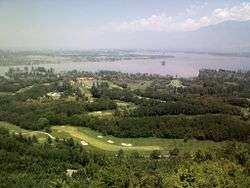
Sports like cricket, football are famous along with sports like golf, skiing, water sports and adventure sports. Srinagar is home to the Sher-i-Kashmir Stadium, a stadium where international cricket matches have been played.[169] The first international match was played in 1983 in which West Indies defeated India and the last international match was played in 1986 in which Australia defeated India by six wickets. Since then no international match has taken place in the stadium due to the prevailing security situation.
Maulana Azad Stadium is a stadium in Jammu and is one of the home venues for the Jammu and Kashmir cricket team. The stadium has hosted home games for Jammu and Kashmir in domestic tournaments since 1966. It has also hosted one One Day International in 1988 between India and New Zealand, which was abandoned due to rain without a ball being bowled. The stadium has played host to one women's test match where India lost to West Indies and one Women's One Day International where India beat New Zealand in 1985.
Srinagar has an outdoor stadium namely Bakshi Stadium for hosting football matches.[170] It is named after Bakshi Ghulam Mohammad.
The city has a golf course named Royal Springs Golf Course, Srinagar located on the banks of Dal lake, which is considered as one of the best golf courses of India.[171]
Ladakh Marathon is held at Leh, is the marathon recognised by Association of International Marathons and Distance Races.[172] Being held at height of 11,500 feet, it is known as the highest marathon in the world.[173] In 2015, Ladakh Marathon was rated among "top ten nicest marathon" in the world.[174]
See also
- Tourism in Jammu and Kashmir
- Jammu
- Srinagar
- Separatist movements of India
- Indian Armed Forces and the Jammu and Kashmir Floods, 2014
- Jammu and Kashmir Legislative Assembly election, 2014
- Outline of India
- Index of India-related articles
- Bibliography of India

- Human rights abuses in Jammu and Kashmir
- Ethnic cleansing of Kashmiri Hindus
- Indian White Paper on Jammu and Kashmir
Notes
- ↑ The Government of Pakistan and Pakistan sources refer to Jammu Kashmir as "Indian-occupied Kashmir" ("IoK") or "Indian-held Kashmir" (IHK),[10][11] "Indian-administered Kashmir" and "Indian-controlled Kashmir" are used by neutral sources.[12][13] Conversely, Indian sources call the territory under Pakistan control "Pakistan-Occupied Kashmir" ("POK") or "Pakistan-Held Kashmir" ("PHK").[14][15]
- ↑ Schofield (2003, p. 54): In his letter to Lord Mountbatten on 26 October 1947, the Maharaja wrote, "I wanted to take time to decide which Dominion I should accede... whether it is not in the best interests of both the Dominions and my State to stay independent, of course with cordial relations with both.
- ↑ Kashmiri leader Sheikh Abdullah noted in the UN Security Council in 1948: ""the (plebiscite) offer (was) made by the Prime Minister of India when, I think, he had not the slightest need for making it, for Kashmir was in distress... The Government of India could have easily accepted the accession and said, "All right, we accept your accession and we shall render this help." There was no necessity for the Prime Minister of India to add the proviso while accepting the accession that "India does not want to take advantage of the difficult situation in Kashmir."(Varshney 1992, p. 195)
- ↑ Korbel (1953, p. 502): "Though India accepted the resolution, Pakistan attached to its acceptance so many reservations, qualifications, and assumptions as to make its answer `tantamount to rejection'.
References
- ↑ "Satya Pal Malik sworn in as Jammu and Kashmir governor". The Economic Times. Press Trust of India. 23 August 2018.
- ↑ "BJP-PDP alliance ends in Jammu and Kashmir LIVE updates: Mehbooba Mufti resigns as chief minister; Governor's Rule in state". Firstpost. 19 June 2018. Retrieved 19 June 2018.
- ↑ "NUN KUN MOUNTAIN".
- ↑ Raina, A.N. "Climate Patterns and Climatic Divisions".
- ↑ "Sub-national HDI - Area Database". Global Data Lab. Institute for Management Research, Radboud University. Retrieved 25 September 2018.
- 1 2 3 "Report of the Commissioner for linguistic minorities: 50th report (July 2012 to June 2013)" (PDF). Commissioner for Linguistic Minorities, Ministry of Minority Affairs, Government of India. p. 49. Archived from the original (PDF) on 8 July 2016. Retrieved 14 January 2015.
- ↑ Jones, Daniel (2003) [1917], Peter Roach, James Hartmann and Jane Setter, eds., English Pronouncing Dictionary, Cambridge: Cambridge University Press, ISBN 3-12-539683-2
- ↑ "What is Article 370? Three key points". The Times of India.
- ↑ "In Depth-the future of Kashmir". BBC News. Retrieved 16 April 2013.
- ↑ Ali Zain (13 September 2015). "Pakistani flag hoisted, pro-freedom slogans chanted in Indian Occupied Kashmir – Daily Pakistan Global". En.dailypakistan.com.pk. Retrieved 17 November 2015.
- ↑ (11 September 2015). "Pakistani flag hoisted once again in Indian Occupied Kashmir | World | Dunya News". Dunyanews.tv. Retrieved 17 November 2015.
- ↑ South Asia: fourth report of session 2006–07 by By Great Britain: Parliament: House of Commons: Foreign Affairs Committee page 37
- ↑ Enforced Disappearances in Indian Occupied Kashmir by Jammu and Kashmir Council for Human Rights (JKCHR)1994
- ↑ Snedden, Christopher (2013). Kashmir: The Unwritten History. HarperCollins India. pp. 2–3. ISBN 9350298988.
- ↑ The enigma of terminology, The Hindu, 27 January 2014.
- ↑ Larson, Gerald James. "India's Agony Over Religion", 1995, page 245
- ↑ Snedden 2003.
- ↑ Guha, Ramachandra (2008), India after Gandhi: The History of the World's Largest Democracy, Pan Macmillian, ISBN 0330396110 : "Pakistan naturally expected Kashmir, with its Muslim majority, to join it. India thought that the religious factor was irrelevant, especially since the leading political party, the National Conference, was known to be non-sectarian."
- ↑ Snedden, Christopher (2015), Understanding Kashmir and Kashmiris, Oxford University Press, pp. 172–, ISBN 978-1-84904-342-7 : "Senior Pakistanis, many of whom had once naively simply expected that J&K would join Pakistan, had come to believe that India had been deliberately conniving with Hari Singh to obtain J&K's accession. To try to prevent India's acquisition, some of these Pakistanis sent the Pukhtoons to capture J&K for Pakistan."
- ↑ "Quick guide: Kashmir dispute". BBC News. 29 June 2006. Retrieved 14 June 2009.
- ↑ "Who changed the face of '47 war?". Times of India. 14 August 2005. Retrieved 14 August 2005.
- ↑ "Archived copy" (PDF). Archived from the original (PDF) on 22 October 2016. Retrieved 8 July 2016.
- ↑ http://shodhganga.inflibnet.ac.in/bitstream/10603/4425/9/09_chapter%202.pdf
- 1 2 Stein, Burton. 1998. A History of India. Oxford University Press. 432 pages. ISBN 0-19-565446-3. Page 368.
- ↑ Šumit Ganguly (13 February 1999). The Crisis in Kashmir: Portents of War, Hopes of Peace. Cambridge University Press. pp. 10–. ISBN 978-0-521-65566-8.
- ↑ "Rediff on the NeT Special: The Real Kashmir Story". Rediff.com. Retrieved 16 April 2013.
- ↑ "Rediff on the NeT: An interview with Field Marshal Sam Manekshaw". Rediff.com. Retrieved 16 April 2013.
- ↑ Varshney 1992, p. 194.
- ↑ Humayun Mirza (1 January 2002). From Plassey to Pakistan: The Family History of Iskander Mirza, the First President of Pakistan. University Press of America. p. 161. ISBN 978-0-7618-2349-0.
- ↑ Nyla Ali Khan (15 September 2010). Islam, Women, and Violence in Kashmir: Between India and Pakistan. Palgrave Macmillan. pp. 30–. ISBN 978-0-230-11352-7.
- ↑ Subramaniam, Arjun (2016), India's Wars: A Military History, 1947–1971, Harper Collins India, ISBN 9351777499 . Excerpt at How the map of Jammu and Kashmir could have been significantly different today, Scroll.in
- ↑ Schofield 2003, p. 70.
- ↑ Varshney 1992, p. 212.
- ↑ Korbel 1953, pp. 506–507.
- ↑ Constitution of Jammu and Kashmir (PDF). Official website of Jammu and Kashmir Legislative Assembly on National Informatics Centre, India. Retrieved 3 April 2015.
- ↑ "1948: Another UNSC Resolution on Kashmir". Archived from the original on 13 December 2014.
- ↑ Bill Emmott. "Bill Emmott: If Saddam steps out of line we must go straight to war". the Guardian.
- ↑ "Low expectations from Indo-Pak talks".
- ↑ "The Rediff Interview/Ashraf Jehangir Qazi".
- ↑ "Don't expect too much from talks: Officials".
- ↑ "Does India have a case in Kashmir?".
- ↑ "Annan upbeat on Kashmir".
- ↑ "Terrorism to feature in talks with Kofi Annan".
- ↑ "We have `left aside' U.N. resolutions on Kashmir: Musharraf".
- ↑ "The Musharraf formula".
- ↑ "Does Pakistan have sincere intention to resolve Kashmir issue: Omar to Musharraf".
- 1 2 "With Friends Like These...": Human Rights Violations in Azad Kashmir. United Nations High Commissioner for Refugees. Archived from the original on 14 March 2012. Retrieved 31 December 2007.
In January 194,
- ↑ Subramanian Swamy (6 February 2003). "India's bleeding head wound". The Hindu. Retrieved 27 March 2010.
- ↑ Hashim Qureshi. "Understanding UN Resolutions on Kashmir". Archived from the original on 23 September 2014.
- ↑ "rediff.com: The Rediff Interview/Pakistan's High Commissioner for India Ashraf Jehangir Qazi". rediff.com.
- ↑ "India repulses Pakistan attack at UN assembly".
- ↑ "Kashmir profile".
- ↑ "Indian, Pakistani and Chinese border disputes-Fantasy frontiers".
- ↑ From Jinnah to Jihad: Pakistan's Kashmir quest and the limits of realism. Atlantic Publishers and Distributors (P) Ltd. 2007. ISBN 978-81-269-0721-2. Retrieved 31 December 2007.
While India had agreed to a plebiscite initially, it reneged, arguing that Pakistan had refused to withdraw its troops, had integrated parts of Kashmir with the rest of the country and had altered their demographic system.
- ↑ Kaul, Shyam; Kachru, Onkar (1 January 1998). Jammu, Kashmir, Ladakh: ringside views. ISBN 978-81-85495-51-4. Retrieved 31 December 2007.
Demographics (1947–48) considered for this UN resolution have changed, most recently with the exodus of a 1/4 million Hindus from Kashmir.
- ↑ "Only 1 Pandit family returned to Valley in 25 years: J&K govt to SC".
- ↑ Kaul, Shyam; Kachru, Onkar (1 January 1998). Jammu, Kashmir, Ladakh: ringside views. ISBN 978-81-85495-51-4. Retrieved 31 December 2007.
Indians are free to migrate as anyone else in a democracy. Yet, as a large group, none of the post-partition (1947) minorities have relocated to India or migrated to Pakistan, Saudi Arabia, or anywhere else in the world under the threat of persecution or insecurity. Ironically, 250,000 Hindus living in Kashmir left Kashmir for India due to the hostile environment created by the militancy in Kashmir.
- ↑ "Jammu and Kashmir Registers Highest Voter Turnout in 25 Years, Jharkhand Breaks Records". Ndtv.com. Retrieved 17 November 2015.
- ↑ PTI. "Jammu and Kashmir people have shown their faith in Indian democracy: PM Narendra Modi – timesofindia-economictimes". Articles.economictimes.indiatimes.com. Retrieved 17 November 2015.
- 1 2 Sikandar Shah (24 January 1957). "Peace not possible without progress on Kashmir issue". The China Post. Retrieved 17 November 2015.
- ↑ Kashmiris want accession to Pakistan: Attique Archived 8 May 2016 at the Wayback Machine.
- ↑ Schofield, Victoria (17 January 2002). "South Asia | Kashmir's forgotten plebiscite". BBC News. Retrieved 2 February 2010.
- ↑ "South Asia | Kashmir's extrajudicial killings". BBC News. 8 March 2007. Retrieved 2 February 2010.
- ↑ Brad Adams, Asia director at Human Rights Watch (31 January 2007). "India: Prosecute Police for Killings in Jammu and Kashmir | Human Rights Watch". Hrw.org. Retrieved 2 February 2010.
- ↑ Brad Adams, Asia director at Human Rights Watch. (9 February 2009). "India: Hold Abusers in Kashmir Accountable | Human Rights Watch". Hrw.org. Retrieved 6 January 2013.
- ↑ "Kashmir's extra-judicial killings". BBC News online. BBC. 8 March 2007. Retrieved 27 March 2010.
- ↑ Somini Sengupta (6 February 2007). "Indian Army and Police Tied to Kashmir Killings". New York Times. Retrieved 27 March 2010.
- ↑ "The Future of Kashmir?". BBC News. Retrieved 2 February 2010.
- ↑ "Kashmir – region, Indian subcontinent". Retrieved 16 November 2016.
- ↑ "Kashmir | region, Indian subcontinent". Encyclopædia Britannica. Retrieved 20 November 2015.
- ↑ Schofield 2003, p. 94
- 1 2 Schofield 2003, p. 137
- ↑ Schofield 2003, p. 210
- ↑ Billal A. Jan (Director) (2012). Ocean of Tears (Excerpt) (YouTube). Jammu and Kashmir: PSBTIndia. External link in
|title=(help) - ↑ "India: "Everyone Lives in Fear": Patterns of Impunity in Jammu and Kashmir: I. Summary". Human Rights Watch. Retrieved 2 June 2008.
- ↑ "India and Human Rights in Kashmir – The Myth – India Together". Retrieved 2 June 2008.
- ↑ Schofield 2003, pp. 148, 158
- ↑ "India: "Everyone Lives in Fear": Patterns of Impunity in Jammu and Kashmir: VI. Militant Abuses". Retrieved 2 June 2008.
- ↑ "Kashmir troops held after rape". BBC News. 19 April 2002. Retrieved 2 June 2008.
- ↑ "219 Kashmiri Pandits killed by militants since 1989". The Hindu. Chennai, India. Retrieved 31 December 2007.
The Jammu and Kashmir government on Tuesday said 219 Kashmiri Pandits were killed by militants since 1989 while 24,202 families were among the total 38,119 families which migrated out of the Valley due to turmoil
- ↑ "Not myth, but the truth of migration". Retrieved 31 December 2007.
The Pandits have preserved the threat letters sent to them. They have the audio and video evidence to show what happened. They have preserved the local newspapers through which they were warned to leave the Valley within 48 hours. This evidence also include still photographs of Pandits killed by militants and the desecrated temples.
- ↑ "Pregnant woman in Doda accuses Lashkar militants of gang raping her repeatedly". The Indian News. Retrieved 31 December 2007.
A 31-year-old pregnant Gujjar woman has told police at the Baderwah Police Station in Jammu and Kashmir's Doda District that she was repeatedly gang raped by Lashkar-e-Toiba militants for two months.
- ↑ "19/01/90: When Kashmiri Pandits fled Islamic terror". Rediff. Retrieved 31 December 2007.
Notices are pasted on doors of Pandit houses, peremptorily asking the occupants to leave Kashmir within 24 hours or face death and worse... In the preceding months, 300 Hindu men and women, nearly all of them Kashmiri Pandits, had been slaughtered following the brutal murder of Pandit Tika Lal Taploo, noted lawyer and BJP national executive member, by the JKLF in Srinagar on September 14, 1989. Soon after that, Justice N K Ganju of the Srinagar high court was shot dead. Pandit Sarwanand Premi, 80-year-old poet, and his son were kidnapped, tortured, their eyes gouged out, and hanged to death. A Kashmiri Pandit nurse working at the Soura Medical College Hospital in Srinagar was gang-raped and then beaten to death. Another woman was abducted, raped and sliced into bits and pieces at a sawmill.
- ↑ "95% HR violation cases against Army in J&K false". zeenews.
- ↑ "2 Militants Killed After 22-Hour Standoff in India Kashmir | Asia | English". .voanews.com. 7 January 2010. Retrieved 18 July 2010.
- 1 2 "Ministry of Home Affairs:: Department of Jammu & Kashmir Affairs". Archived from the original on 8 December 2008. Retrieved 28 August 2008.
- 1 2 3 4 5 6 7 "District Census 2011". 2011-01-01.
- ↑ "Reference Tables, A-series : Population". Census of India 2001. Retrieved 17 April 2009.
- ↑ "Census Population" (PDF). Census of India. Ministry of Finance India. Retrieved 18 December 2008.
- 1 2 "Population by religion community – 2011". Census of India, 2011. The Registrar General & Census Commissioner, India. Archived from the original on 25 August 2015.
- ↑ "Department of Tourism, Jammu and Kashmir". jktourism.org.
- ↑ "Share of Muslims and Hindus in J&K population same in 1961, 2011 Censuses".
- 1 2 Calculated from the 2011 Census India: Population by Religious Community
- ↑ "Are Kashmiri Shias The Next Pandits?". Archived from the original on 21 June 2015. Retrieved 16 June 2015.
- ↑ "Signs of Support in Kashmir for Islamic State Alarm Intel Agencies".
- ↑ Evans, Alexander. 2002. "A departure from history: Kashmiri Pandits, 1990–2001" Contemporary South Asia, 11(1):19–37.
- ↑ CIA – The World Factbook Archived 9 May 2007 at the Wayback Machine.
- ↑ Share of Muslims and Hindus in J&K population same in 1961, 2011 Censuses, Indian Express, 30 December 2016.
- 1 2 Korbel, Danger in Kashmir 1966, p. 153.
- ↑ Snedden, Christopher, "What happened to Muslims in Jammu? Local identity, '"the massacre" of 1947' and the roots of the 'Kashmir problem'", South Asia: Journal of South Asian Studies, 24 (2): 111–134, doi:10.1080/00856400108723454
- ↑ Evans, Alexander (1 March 2002). "A departure from history: Kashmiri Pandits, 1990–2001". Contemporary South Asia. 11 (1): 19–37. doi:10.1080/0958493022000000341. ISSN 0958-4935.
- ↑ "Kashmir: The Predicament – Commentary". 5 January 2009. Archived from the original on 5 January 2009. Retrieved 31 July 2016.
- ↑ "Kashmiri: A language of India". Ethnologue. Retrieved 16 September 2007.
- ↑ Bhat, M. Ashraf (9 September 2011). Emergence of the Urdu Discourses in Kashmir (11 ed.). LANGUAGE IN INDIA.
|access-date=requires|url=(help) - ↑ Farouqi, Ather (2006). Redefining Urdu Politics in India. New Delhi: Oxford University Press.
|access-date=requires|url=(help) - ↑ Pandharipande, Rajeshwari (2002), "Minority Matters: Issues in Minority Languages in India" (PDF), International Journal on Multicultural Societies, 4 (2): 3–4
- ↑ Kachru, Braj B.; Kachru, Yamuna; Sridhar, S. N. (27 March 2008), Language in South Asia, Cambridge University Press, pp. 132–, ISBN 978-1-139-46550-2
- 1 2 "Descent into Chaos". Epaper.timesofindia.com. 16 September 2010. Retrieved 16 April 2013.
- ↑ States: Jammu & Kashmir: Repeating History:By Harinder Baweja (3 July 2000)India Today Archived 21 October 2007 at the Wayback Machine.
- ↑ "Under BJP pressure, J&K withdraws flag order". The Hindu. 14 March 2015. Retrieved 28 April 2015.
- ↑ "Sorry". Indianexpress.com. Retrieved 18 July 2010.
- ↑ The Constitution of Jammu and Kashmir Archived 7 May 2012 at the Wayback Machine.
- ↑ The Armed Forces (Jammu and Kashmir) Special Powers Act, 1990" Indian Ministry of Law and Justice Published by the Authority of New Deli
- ↑ "India: Repeal Armed Forces Special Powers Act Human Rights Watch. Retrieved 11 September 2008.
- ↑ "India: Accountability still missing for human rights violations in Jammu and Kashmir". Amnesty International. Retrieved 16 November 2016.
- ↑ "India: Accountability still missing for human rights violations in Jammu and Kashmir". Amnesty International. Retrieved 31 August 2016.
- ↑ "Constitution of Jammu and Kashmir Section 4 Read with Section 48(a)". Kashmir-information.com. Archived from the original on 7 May 2013. Retrieved 16 April 2013.
- ↑ Luv Puri (24 October 2002). "The vacant seats". Online edition of The Hindu, dated 24 October 2002. Chennai, India. Retrieved 9 April 2009.
- ↑ Rasheeda Bhagat (27 October 2005). "It is introspection time for Congress in J&K". The Hindu Businessline. Archived from the original on 6 January 2006. Retrieved 9 April 2009.
- ↑ "Govt plans to reduce J&K Assembly's term to 5 years". The Tribune. 19 November 2005. Retrieved 28 January 2009.
- ↑ "Jammu and Kashmir Assembly Elections 2002: Ending National Conference's Reign:30 October 2002 By S.H.Imam (J&K Insight)". Jammu-kashmir.com. 30 October 2002. Retrieved 16 April 2013.
- ↑ "PDP withdraws support from J&K government(By Mukhtar Ahmad in Srinagar)28 June 2008 19:03 IST (Rediff News)". Rediff.com. Retrieved 16 April 2013.
- ↑ "Pro-India parties win majority in Kashmir elections". CNN. 28 December 2008. Retrieved 5 May 2010.
- ↑ "1989 Insurgency". Kashmirlibrary.org. Retrieved 6 January 2013.
- ↑ "Contours of militancy". Retrieved 16 November 2016.
- ↑ "Timeline of the conflict". BBC News. Retrieved 6 January 2013.
- ↑ "India Pakistan – Timeline". BBC News. BBC News. Retrieved 10 April 2015.
- ↑ PMO in secret talks with secessionists, The Hindu, 25 January 2006
- ↑ Malik Under Fire, Rebels Call For 'less Autocratic' JKLF, The Indian Express, 23 December 2005
- ↑ Huey, Caitlin (28 March 2011). "Amnesty International Cites Human Rights Abuse in Kashmir". U.S. News & World Report. Retrieved 6 January 2013.
- 1 2 3 "Kashmir graves: Human Rights Watch calls for inquiry". BBC News. 25 August 2011. Retrieved 30 July 2012.
- ↑ "Asia Pacific Human Rights by region". Amnesty International. Retrieved 30 July 2012.
- ↑ A.G. Noorani. "Article 370 : Law and politics". Online edition of Frontline magazine, Volume 17 – Issue 19, Sep. 16–29, 2000. Archived from the original on 23 December 2008. Retrieved 28 January 2009.
- ↑ Avijit Ghosh (17 August 2008). "In Kashmir, there's azadi in air". Online edition of The Times of India, dated 17 August 2008. Retrieved 28 January 2009.
- ↑ Thottam, Jyoti (4 September 2008). "Valley of Tears". Time. Retrieved 5 May 2010.
- ↑ Yasir, Sameer (January 2, 2017). "Kashmir unrest: What was the real death toll in the state in 2016?". Firstpost. Retrieved 27 January 2017.
- ↑ Akmali, Mukeet (January 23, 2017). "After 15000 injuries, Govt to train forces in pellet guns". Greater Kashmir. Retrieved 27 January 2017.
- 1 2 "Freedom in the World 2009 – Kashmir (India)". Freedom House. 16 July 2009. Retrieved 10 December 2009.
- 1 2 "Freedom in the World 2009 – Kashmir (Pakistan)". Freedom House. 16 July 2009. Retrieved 10 December 2009.
- ↑ Express Web Desk (June 16, 2017). "Six policemen, including sub-inspector, killed in militant ambush in Anantnag, Jammu and Kashmir". Online edition of The Indian Express, dated June 16, 2017. Retrieved June 20, 2017.
- 1 2 3 4 5 6 "Jammu and Kashmir Budget Analysis 2016–17" (PDF). PRS Legislative Research. Retrieved 9 February 2017.
- ↑ Michelsen, Leslee (2013). Ferozkoh: Tradition and Continuity in Afghan Art (English Edition). A&C Black. p. 99. ISBN 978-9992195987.
'If there be Paradise on earth, it is here, it is here, it is here'. This Persian couplet invokes the heavenly realms. The verse was inscribed at the Shalimar Gardens in Kashmir, founded by the Mughal emperor Jahangir in 1620, (...)
- ↑ Kabir, Ananya Jahanara (2009). Territory of Desire: Representing the Valley of Kashmir. U of Minnesota Press. p. 212. ISBN 978-0816653560.
However, the association between his [Jahangir's] love of Kashmir and the Persian couplet (...), appears to be an urban legend of sorts. The couplet is by the Sufi poet of Delhi, Amir Khusrau Dehlavi (1253–1325 CE), (...)
- ↑ Blake, Stephen P. (2002). Shahjahanabad: The Sovereign City in Mughal India 1639–1739. Cambridge: Cambridge University Press. p. 44. ISBN 978-0521522991.
This same inscription is also found in the Shalimar garden in Kashmir, built by the Emperor Jahangir in the early part of his reign.
- ↑ "CHAPTER III : Socio-Economic and Administrative Development" (PDF). Jammu & Kashmir Development Report. State Plan Division, Planning Commission, Government of India. Retrieved 5 August 2009.
- 1 2 "CHAPTER IV : Potential Sectors of State Economy" (PDF). Jammu & Kashmir Development Report. State Plan Division, Planning Commission, Government of India. Retrieved 5 August 2009.
- ↑ "India: Jammu registers 10,000 MTs increase in fruit production in 2 years". GreaterKashmir.com. 5 October 2007. Archived from the original on 24 March 2010. Retrieved 25 January 2009.
- ↑ PTI (10 February 2008). "Demand for Mercedes in Jammu going up: Merc dealer". The Economic Times. Archived from the original on 3 January 2009. Retrieved 25 January 2009.
- ↑ Haroon Mirani (20 June 2008). "Sapphire-rich Kashmir". The Hindu Business Line. Archived from the original on 2 November 2009. Retrieved 5 August 2009.
- ↑ "Funds sought for SEZs: ASSOCHAM identifies key sectors for J&K's development". Chennai, India: The Hindu. 7 April 2008. Retrieved 25 January 2009.
- ↑ PTI (18 June 2007). "Kashmir, the economy looks up". The Economic Times. Retrieved 25 January 2009.
- ↑ "Power shortage to hit India Inc". Rediff News. 2 April 2008. Retrieved 25 January 2009.
- ↑ "J&K Bank Q4 net up 32% at Rs 598 mn". Livemint. 2 June 2008. Retrieved 5 August 2009.
- 1 2 Amy Waldman (18 October 2002). "Border Tension a Growth Industry for Kashmir". The New York Times. Retrieved 5 August 2009.
- ↑ Harish Kunwar. "Train-Link for J & K Prosperity". Press Release, Press Information Bureau, Government of India, dated 16 October 2008. Retrieved 25 November 2008.
- ↑ "Jammu and Kashmir Budget Analysis 2016–17". PRS Legislative Research. Retrieved 27 January 2017.
- ↑ 2015 agricultural output of Jammu and Kashmir based on 2011 prices
- ↑ "Amarnath Board to study yatra impact on Kashmir economy". Online edition of The Hindu, dated 13 September 2007. Chennai, India. 13 September 2007. Retrieved 6 June 2009.
- ↑ "Vaishno Devi yatra injects Rs 475 cr to Katra economy annually(CJ: Rattan Sharma, 27 Aug 2007)". Merinews.com. 27 August 2007. Retrieved 16 April 2013.
- ↑ "India travel advice – GOV.UK". Fco.gov.uk. 9 April 2013. Retrieved 16 April 2013.
- ↑ "Foreign tourists flock Kashmir". Online edition of The Hindu, dated 18 March 2009. Chennai, India. 18 March 2009. Retrieved 18 March 2009.
- ↑ Prystay, Cris (26 October 2007). "Fairway to Heaven – WSJ.com". Online.wsj.com. Retrieved 16 April 2013.
- ↑ "Tourists arrival gives boost to J-K economy". Sify.com. 29 December 2009. Retrieved 16 April 2013.
- ↑
- ↑ Tourists back in Kashmir. YouTube. 24 July 2011.
- ↑ "Welcome to Jammu and Kashmir's new tourist hot-spot". NDTV.com. 29 May 2011.
- ↑ "J-K Accession Day to be celebrated as Diwali: BJP". Rediff. Retrieved 31 December 2007.
- ↑ Muhammad Zaka Ur Rub (6 October 2017). "Atiqa Bano, the lady who single handedly built a museum". Greater Kashmir. Retrieved 24 October 2017.
- ↑ "Records / Sher-i-Kashmir Stadium, Srinagar / One-Day Internationals". ESPNCricinfo. Archived from the original on 13 August 2014. Retrieved 7 December 2012.
- ↑ "J&K stadium hosts football match after 25-year gap". Times of India. 16 July 2012. Retrieved 7 December 2012.
- ↑ "India". Robert Trent Jones – Golf Architects. Retrieved 21 September 2012.
- ↑ "AIMS – Calendar of Races". Aimsworldrunning.org. 11 November 2015. Retrieved 17 November 2015.
- ↑ "LAHDC organises 3rd Ladakh Marathon at Leh | Business Standard News". Business-standard.com. Retrieved 17 November 2015.
- ↑ "4,000 runners ready for Ladakh Marathon tomorrow". Tribuneindia.com. 12 September 2015. Retrieved 17 November 2015.
- Sources
- Korbel, Josef (1953), "The Kashmir dispute after six years", International Organization, Cambridge University Press, 7 (4): 498–510, doi:10.1017/S0020818300007256, (Subscription required (help))
- Korbel, Josef (1966) [first published 1954], Danger in Kashmir (second ed.), Princeton University Press
- Schofield, Victoria (2003), Kashmir in Conflict, I.B.Tauris, ISBN 1-86064-898-3
- Snedden, Christopher (3 May 2003), Kashmir – The Untold Story, India: HarperCollins Publishers
- Varshney, Ashutosh (1992), "Three Compromised Nationalisms: Why Kashmir has been a Problem" (PDF), in Raju G. C. Thomas, Perspectives on Kashmir: the roots of conflict in South Asia, Westview Press, pp. 191–234, ISBN 978-0-8133-8343-9
Further reading
- Bose, Sumantra (2003), Kashmir: Roots of Conflict, Paths to Peace, Harvard University Press, ISBN 0-674-01173-2
- Rai, Mridu (2004), Hindu Rulers, Muslim Subjects: Islam, Rights, and the History of Kashmir, C. Hurst & Co, ISBN 1850656614
External links
- Government
- General information
- Jammu and Kashmir Encyclopædia Britannica entry
- Jammu and Kashmir at Curlie (based on DMOZ)

